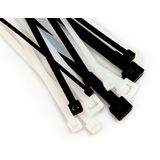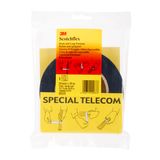3M Cable ties



3M cable ties range and structure for panels, plants and fit-outs
This category covers standard and specialty ties that actually speed routing: indoor nylon ties for cabinet looms, UV and heat-stable grades for rooftops and plant rooms, stainless-reinforced for tough zones, plus mounts, saddles and ID plates that turn a bundle into a labelled route. 3M structures the offer by material (PA6.6, weather/heat-stabilised, metal-tooth), format (standard, low-profile head, marker, coloured) and fixing style (through-hole, screw-mount, adhesive base).
3M nylon cable ties sizes, pull strengths and pack logic
Widths typically 2.5–9.0 mm, lengths 100–780 mm, with tensile classes from ~80 N for light I/O looms to 535 N for tray runs. Most installers standardise three SKUs: 2.5×200 mm for control wiring, 4.8×300 mm as the workhorse, and 7.6×370 mm for trunk bundles. Colours: natural for cabinets, black UV for outdoor and drive rooms where heat and light attack plastics. Packaging is contractor-friendly—bags of 100 for common sizes, 50 for heavy ties—so line-side bins stay balanced.
3M reusable cable ties when they beat single-use straps
Releasable heads shine in commissioning, FAT/SAT, and service bays where harnesses are reworked. They reduce plastic scrap, keep labels intact and avoid cutting near sensitive insulation. Stock one light and one medium size; use them for temporary staging, then lock permanent routes with standard ties at sign-off. Tip: pair with marker sleeves so technicians can move IDs without reprinting.
3M cable management applications and compatibility across the build
Use slim ties inside DIN-rail cabinets, low-profile heads behind HMI doors, heat/UV grades on rooftops and compressor rooms, and metal-tooth types near hot drives or oils. Ties sit with ducts, terminals and glands; screw-mount bases align to 25/50 mm back-plate grids. For EMC, keep bundles short from gland to PE clamp; avoid choking shielded cables—one tie every 10–15 cm is a safe rule.
Mounting bases, saddles and ID solutions that finish the job
Adhesive bases speed retrofit on painted doors; screw-mount saddles hold in vibration. Arrow-head and fir-tree anchors snap into ø6–7 mm panels and carriages. ID ties and clip-on plates keep circuit codes visible at tray drops and device tails—auditors love them. Treat these as 3m cable fixing accessories in stores so replenishment is one click.
Specifications that matter to buyers and installers
- Material and environment. PA6.6 for cabinets; weather/heat-stabilised for UV and 85–105 °C zones; stainless-tooth for oils and heat.
- Strength and safety. Choose tensile class with 20–30 % headroom; wide ties reduce pinch on soft jackets
- Temperature band. Look for –40…+85 °C typical; elevated grades cover up to +105 °C.
- Fire and halogen. Low-smoke, halogen-free options for public buildings and transport.
- Edges and finish. Rounded tails and deburred heads reduce glove snags and insulation nicks.
- Packaging. Moisture-barrier bags on sensitive grades; keep sealed until use in humid shops.
Selection checklist for B2B clients
- Route location. Cabinet interior → natural PA; outdoor/drive hall → UV/heat-stabilised; hot/oily → stainless-tooth.
- Bundle size. Match max ø plus 20 % growth; step up width instead of over-tensioning.
- Fixing method. Adhesive bases for finished doors; screw saddles for vibration; fir-tree where drilling is limited.
- Service model. Releasable ties for commissioning; permanent ties for handover; ID plates wherever audits occur.
- Label plan. Use marker plates or print sleeves every change of route; illegible bundles drive call-backs.
- Kit completeness. Order ties + bases + edge clips + ID plates + flush cutters so crews don’t improvise.
Procurement and stocking notes with fast movers
Most shops run a three-bin system: 2.5×200 (100-packs), 4.8×300 (100-packs), 7.6×370 (50-packs), plus black UV versions of the middle size. Add one bag of releasables and mixed adhesive bases per cabinet batch. On the shelf next door, group ferrules and sleeves under 3m electrical wiring accessories—teams build cleaner when smalls sit together. For desk harnesses and AV racks, some buyers file coloured assortments as 3m wire organizers to separate them from industrial black/natural stock.
Integration with related brand categories for a complete basket
Ties pair naturally with Weidmüller terminal blocks, DIN rails, cable glands and shield clamps. Adhesive bases follow the same IPA-wipe routine you use before fitting plaques or VHB pads. For route changes, keep spare duct fingers, grommets and PE bars on the same PO; installers finish once instead of revisiting.
Advantages of working with Bankoflamps that matter to ops teams
Individual B2B pricing and custom offers, a personal account manager, and real-time stock across EU warehouses. Quotes come back fast (≈1 hour). Ordering by EAN/MPN is simple with downloadable, always-current price lists. You get lead-time tracking, order status, purchase-history analytics and—if approved—post-payment up to 30 days. We consolidate shipments to cut freight with price validity windows across France, the Baltics, Germany, Spain, Italy, Belgium and the Netherlands.